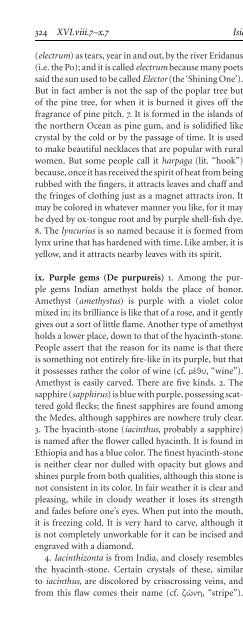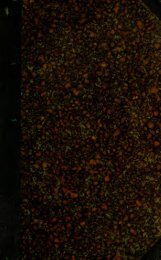The Etymologies of Isidore of Seville - Pot-pourri
The Etymologies of Isidore of Seville - Pot-pourri
The Etymologies of Isidore of Seville - Pot-pourri
Create successful ePaper yourself
Turn your PDF publications into a flip-book with our unique Google optimized e-Paper software.
324 XVI.viii.7–x.7 <strong>Isidore</strong> <strong>of</strong> <strong>Seville</strong><br />
(electrum)astears, year in and out, by the river Eridanus<br />
(i.e. the Po); and it is called electrum because many poets<br />
said the sun used to be called Elector (the ‘Shining One’).<br />
But infact amber is not the sap <strong>of</strong> the poplar tree but<br />
<strong>of</strong> the pine tree, for when it is burned it gives <strong>of</strong>f the<br />
fragrance <strong>of</strong> pine pitch. 7. Itisformed in the islands <strong>of</strong><br />
the northern Ocean as pine gum, and is solidified like<br />
crystal by the cold or by the passage <strong>of</strong> time. It is used<br />
to make beautiful necklaces that are popular with rural<br />
women. But some people call it harpaga (lit. “hook”)<br />
because, once it has received the spirit <strong>of</strong> heat from being<br />
rubbed with the fingers, it attracts leaves and chaff and<br />
the fringes <strong>of</strong> clothing just as a magnet attracts iron. It<br />
may be colored in whatever manner you like, for it may<br />
be dyed by ox-tongue root and by purple shell-fish dye.<br />
8. <strong>The</strong>lyncurius is so named because it is formed from<br />
lynx urine that has hardened with time. Like amber, it is<br />
yellow, and it attracts nearby leaves with its spirit.<br />
ix. Purple gems (De purpureis) 1. Amongthe purple<br />
gems Indian amethyst holds the place <strong>of</strong> honor.<br />
Amethyst (amethystus) is purple with a violet color<br />
mixed in; its brilliance is like that <strong>of</strong> a rose, and it gently<br />
givesout a sort <strong>of</strong> little flame. Another type <strong>of</strong> amethyst<br />
holds a lower place, down to that <strong>of</strong> the hyacinth-stone.<br />
People assert that the reason for its name is that there<br />
is something not entirely fire-like in its purple, but that<br />
it possesses rather the color <strong>of</strong> wine (cf. , “wine”).<br />
Amethyst is easily carved. <strong>The</strong>re are five kinds. 2. <strong>The</strong><br />
sapphire (sapphirus)isblue with purple, possessing scattered<br />
gold flecks; the finest sapphires are found among<br />
the Medes, although sapphires are nowhere truly clear.<br />
3. <strong>The</strong> hyacinth-stone (iacinthus, probablyasapphire)<br />
is named after the flower called hyacinth. It is found in<br />
Ethiopia and has a blue color. <strong>The</strong> finest hyacinth-stone<br />
is neither clear nor dulled with opacity but glows and<br />
shines purple from both qualities, although this stone is<br />
not consistent in its color. In fair weather it is clear and<br />
pleasing, while in cloudy weather it loses its strength<br />
and fades before one’s eyes. When put into the mouth,<br />
it is freezing cold. It is very hard to carve, although it<br />
is not completely unworkable for it can be incised and<br />
engraved with a diamond.<br />
4. Iacinthizonta is from India, and closely resembles<br />
the hyacinth-stone. Certain crystals <strong>of</strong> these, similar<br />
to iacinthus, are discolored by crisscrossing veins, and<br />
from this flaw comes their name (cf. , “stripe”).<br />
5. Amethystizontas is so named because the sparkle on<br />
its surface ranges towards the violet color <strong>of</strong> amethyst.<br />
6. Chelidonia is named after the color <strong>of</strong> a swallow (cf.<br />
,“swallow”). <strong>The</strong>re are two kinds: one <strong>of</strong> them is<br />
purple on one side, and the other purple with scattered<br />
black spots. 7. Cyanea (i.e. a type <strong>of</strong> lapus lazuli) is a gem<br />
from Scythia glittering with a blue sheen, either pure<br />
blue, or sometimes varied with flecks <strong>of</strong> flickering gold.<br />
8. Rhoditis is rosy, and takes its name from this quality<br />
(cf. ,“rose”).<br />
x. White gems (De candidis) 1. <strong>The</strong> pearl is the most<br />
excellent <strong>of</strong> the white gems. People say it is called a pearl<br />
(margarita)because this kind <strong>of</strong> stone is found in shellfish<br />
from the sea (mare), for it consists <strong>of</strong> a pebble formed<br />
in the flesh <strong>of</strong> a shellfish, like the little stone in the brain<br />
<strong>of</strong> a fish (see section 8 below). It is made from celestial<br />
dew, which shellfish absorb at a certain season <strong>of</strong><br />
the year. A certain pearl is called a unio, anapt name<br />
because only one (unus) isfound at a time, never two<br />
or more. White pearls are preferable to those that are<br />
yellow. Youth, or the reception <strong>of</strong> morning dew, makes<br />
pearls white; old age, or evening air, produces dark ones.<br />
2. <strong>The</strong>opal (paederos) holds second place among the<br />
white gems, after the pearl. One may ask <strong>of</strong> this gem<br />
under what color it should be classified, given that its<br />
name is applied to other sorts <strong>of</strong> beauty so frequently<br />
that it has become merely a term that promises beauty.<br />
3. Asterites is white and contains a light enclosed within<br />
it like a star floating about inside. It reflects white rays<br />
<strong>of</strong> sunlight, whence it finds its name (cf. , “star,<br />
flame”).<br />
4. Galactitis is milky (cf. , gen. ,<br />
“milk”); when rubbed it gives <strong>of</strong>f a white fluid tasting<br />
<strong>of</strong> milk. When tied onto nursing women it makes their<br />
breasts productive. It is also said to make an infant’s<br />
mouth water when it is hung around its neck. It becomes<br />
liquid in the mouth and obliterates memory. <strong>The</strong> rivers<br />
Nile and Achelous yield this stone. Some people call a<br />
smaragdus banded with white veins a galactitis. 5. Chalazias<br />
has the shape and whiteness <strong>of</strong> a hailstone (cf.<br />
, “hail”); it is also invincibly hard, like a diamond.<br />
Even when placed on the fire it retains its coldness.<br />
6. Solis is a white gem, and has this name because it<br />
casts its rays in the form <strong>of</strong> the sun (sol) shining on the<br />
world. 7.Selenite(selenitis)istranslucentwith a whitish<br />
honey-like gleam; it contains the image <strong>of</strong> the moon (cf.

















